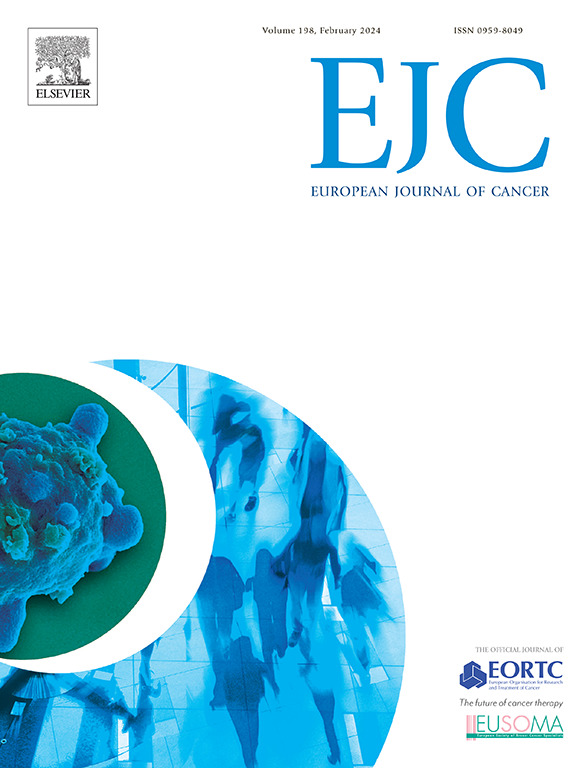Induction chemotherapy followed by chemoradiation in locally advanced cervical cancer: Quality of life outcomes of the GCIG INTERLACE trial
IF 7.6
1区 医学
Q1 ONCOLOGY
引用次数: 0
Abstract
Aim
Induction chemotherapy (IC) added to chemoradiation (CRT) in locally advanced cervical cancer (LACC) improves survival at the expense of adverse events (AEs), 99 % with IC/CRT vs 95 % CRT alone, 59 % vs 48 % G3/4 AEs. We investigated the impact of this on quality of life (QoL).
Methods
500 women with FIGO 2008 stage IB1 node positive, IB2, II, IIIB and IVA cervical carcinoma were randomised to CRT alone or IC (6 weeks carboplatin AUC2 paclitaxel 80mg/m2) followed by CRT. QoL questionnaires (EORTC QLQ-C30 v3, QLQ-CX24) were completed at baseline, D1 week 4 IC, D1 CRT, D1 week 3 CRT, 4 weeks post CRT and all follow up visits. Mixed modelling for repeated measures was used to compare the groups during trial treatment to 2 years follow up (adjusting for baseline).
Results
QoL (global health status, physical and social functioning) slightly worsened during IC and symptom experience slightly improved. Emotional functioning improved during IC.
Peripheral neuropathy was slightly worse with IC/CRT. Fatigue and nausea/vomiting worsened from baseline to week 4 IC whilst pain and diarrhoea improved, consistent with reported AEs. Over the whole period, mean differences for these symptoms between the treatment groups was small and not clinically significant and resolved by 12–18 months.
In all cases, mean score differences during trial treatment until 2 years post CRT showed only small differences (<5 units) not meeting the threshold for clinical relevance.
Conclusion
IC added to CRT does not adversely impact QoL compared to CRT, either during IC, during CRT or later.
局部晚期宫颈癌诱导化疗后化疗放疗:GCIG INTERLACE试验的生活质量结果
目的局部晚期宫颈癌(LACC)患者在化疗(CRT)基础上进行诱导化疗(IC)可提高生存率,但同时也会增加不良反应(AEs),其中IC/CRT的不良反应发生率为99%,单用CRT的不良反应发生率为95%,G3/4级不良反应发生率为59%,单用CRT的不良反应发生率为48%。我们调查了这对生活质量(QoL)的影响。方法:500 名患有 FIGO 2008 IB1 期结节阳性、IB2、II、IIIB 和 IVA 宫颈癌的妇女被随机分配到单纯 CRT 或 IC(6 周卡铂 AUC2 紫杉醇 80mg/m2),然后进行 CRT。在基线、第1周第4次IC、第1周CRT、第1周第3次CRT、CRT后4周和所有随访中填写了QoL问卷(EORTC QLQ-C30 v3、QLQ-CX24)。结果在 IC 期间,QoL(总体健康状况、身体和社会功能)略有恶化,症状体验略有改善。IC 治疗期间,情绪功能有所改善。IC/CRT 治疗期间,周围神经病变略有恶化。从基线到 IC 第 4 周,疲劳和恶心/呕吐有所加重,而疼痛和腹泻有所改善,这与报告的 AE 一致。在整个治疗期间,治疗组之间这些症状的平均差异很小,没有临床意义,并在 12-18 个月时消失。在所有病例中,试验治疗期间到 CRT 治疗后 2 年的平均分数差异很小(5 个单位),没有达到临床意义的临界值。
本文章由计算机程序翻译,如有差异,请以英文原文为准。
求助全文
约1分钟内获得全文
求助全文
来源期刊

European Journal of Cancer
医学-肿瘤学
CiteScore
11.50
自引率
4.80%
发文量
953
审稿时长
23 days
期刊介绍:
The European Journal of Cancer (EJC) serves as a comprehensive platform integrating preclinical, digital, translational, and clinical research across the spectrum of cancer. From epidemiology, carcinogenesis, and biology to groundbreaking innovations in cancer treatment and patient care, the journal covers a wide array of topics. We publish original research, reviews, previews, editorial comments, and correspondence, fostering dialogue and advancement in the fight against cancer. Join us in our mission to drive progress and improve outcomes in cancer research and patient care.
 求助内容:
求助内容: 应助结果提醒方式:
应助结果提醒方式:


